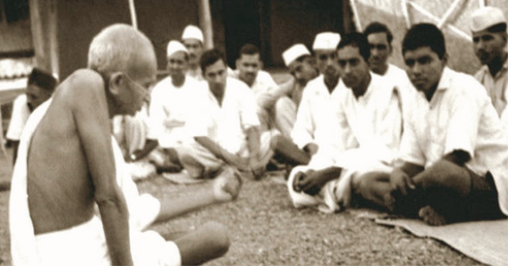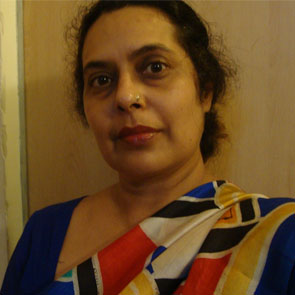In recent times, there has been a lot of criticism levelled against Gandhi’s attitude to the caste system and untouchability, especially by political entities like the Bahujan Samaj Party (BSP) and Dalit leaders. The contrasting viewpoints of Ambedkar and Gandhi on the matter of tackling untouchability is often cited, as proof of Gandhi’s insincerity in dealing with the problem.
To be sure, Gandhi represented a moderate viewpoint, and in keeping with his principles, was not for a direct condemnation of Hinduism or the division of labour that the caste system entailed. He rightly saw it as throwing the baby out with the bath water. He often referred to the varna system, as the foundation on which Indian society was laid, and saw casteism and untouchability as a degraded form of the well-founded division of labour which needed to be rooted out. However, he wanted the upper castes to realise the wrongs perpetrated on the outcastes and scheduled castes, rather than launch an attack on the system. Ambedkar, on the other hand, had faced caste discrimination first-hand, and hence, declared, that he would never “die a Hindu.”
Gandhi`s fight against casteism
If we are to evaluate Gandhi’s role in the affirmative action enshrined in our Constitution, in favour of the scheduled castes and tribes, we need to understand that Gandhi, in spite of never having had to face untouchability or caste discrimination, had the sensitivity even as a child in a privileged middle class home in Porbandar, to feel the wrong being perpetrated on another human being.
To understand the extent and depth of affirmative action in India, we need to realise that the India in which Gandhi lived as a child two centuries ago, did not see Dalits or Bahujan as deserving to be treated as equal human beings. A man or woman belonging to a scheduled caste or tribe was denied education, never allowed to enter temples or walk freely in a public place. There was no avenue for progress or growth. In the absence of education, Dalits could never develop any leadership skills, or even have leaders who could rise and demand their rights. Centuries of subjugation had taught the Dalit to acquiesce in his downtrodden state. It was people like Gandhi, who, in going against the social norm, enlightened the upper-caste gentry to the wrongs perpetrated against an entire mass of people.
Of course, Gandhi’s was certainly not the lone voice against casteism. There were others too, such as Periyar in the south, and litterateurs like Premchand in north India, who had dissented strongly against the practice. Gandhi travelled south to take part in the Vaikom satyagraha in Kerala, that demanded the entry of Dalits into temples. Although the satyagraha could not achieve its objective, it did manage to have the roads around the temple to be made accessible to Dalits. But in a vindication of sorts, in a few years following it, the state of Travancore-Cochin threw open all temples to outcastes and Dalits.
Contrarian views
Ambedkar abhorred and condemned both varna and caste, since the former was the “parent” of caste. However, Gandhi upheld varna, and its division of labour, which had inherent advantages in the dissemination of skills within families, although he condemned the rigidity of caste, and the blot of untouchability in Indian society.
Gandhi had objected to separate electorates as demanded by Babasaheb Ambedkar; but he had consented to more seats for the untouchables under the Poona Pact. Perhaps, it was a political ploy to prevent divisions within the Indians from affecting the fight for Indian independence. But he tried his level best to awaken the nation to the injustice against the Dalits, and even coined a new term for them ‘Harijans’. He dedicated an entire newspaper, The Harijan, to fight social injustice, and his writings drew attention to the plight of untouchable Christian converts in Kumbakonam, who were prevented from praying with upper castes in their churches, the imposition of beggar ( unpaid forced labour) on untouchables in the United Provinces, as also the prevention of untouchables from using palkhis or dandis in the Garhwal hills. Gandhi also started the Harijan Seva Sangh with volunteers within the Congress, to improve the living conditions of untouchables, and report on atrocities faced by Dalit untouchables. He also ensured that there were no separate seating arrangements for the untouchables at his meetings, and took especial interest in seeing that there was intermingling of people in the audience.
Empathetic to Dr Ambedkar’s angst at the “ forced” poverty and scavenging imposed on the untouchables, courtesy Hindu texts, Gandhi nevertheless countered by stating: “In my opinion, the profound mistake that Dr. Ambedkar has made ….is to pick out the texts of doubtful authenticity and value, and the state of degraded Hindus who are no fit specimens of the faith they so woefully misrepresent……Can a religion that was professed by Chaitanya, Jnandeva, Tukaram, Toruvalluvar, Ramakrishna Paramahamsa, Raja Ram Mohun Roy, Maharshi Devendranath Tagore, Vivekananda, be so utterly devoid of merit…..?”
It is true that Dr Babasaheb Ambedkar paved the way for Dalit emancipation in the new India through our Constitution, that boldly declared- as per Article 17: “Untouchability” is abolished and its practice in any form is forbidden. The enforcement of any disability arising out of “Untouchability” shall be an offence punishable in accordance with law.
Articles 15 (1) and (2) declare clearly that :
“The State shall not discriminate against any citizen on grounds only of religion, race, caste, sex, place of birth or any of them”; and
“No citizen shall, on grounds only of religion, race, caste, sex, place of birth or any of them, be subject to any disability, liability, restriction or condition with regard to – (a) access to shops, public restaurants, hotels and places of public entertainment; or (b) the use of wells, tanks, bathing ghats, roads and places of public resort maintained wholly or partly out of State funds or dedicated to the use of the general public.”
Similarly, we have Article 16, declaring that :
(1) There shall be equality of opportunity for all citizens in matters relating to employment or appointment to any office under the State.
(2) No citizen shall, on grounds only of religion, race, caste, sex, descent, place of birth, residence or any of them, be ineligible for, or discriminated against in respect of, any employment or office under the State.
The Constitution further declares, the intention of the State of
“making special provision for the advancement of any socially and educationally backward classes of citizens or for the Scheduled Castes and the Scheduled Tribes” in educational institutions, unimpeded by the provisions in Articles 15, 16 or 29.
Without Gandhi awakening people to the plight of untouchables in Indian society, it is unlikely that affirmative action could be introduced in India in the 50’s, as a necessary tool to correct a historical wrong.
Affirmative action that brought a change
Our Constitution brought in vertical mobility in life for an entire generation of people, and also gave us leading Dalit intellectuals in many fields. If Ambedkar and the Indian state gifted economic strength, and a political voice to the Dalits, Gandhi and many others like him, gave them social acceptance. Affirmative action gave us literary figures like Namdeo Dhasal, politicians like Mayawati, and the young Jignesh Mewani , economists like Narendra Jadhav who could aspire to a better life and position through education. Noted Marathi Dalit writer Urmila Pawar, in her autobiography ‘Aaydan- The weave of my life’, has clearly acknowledged the role the scheduled caste quota played in helping her, and members of her scheduled caste Mahar family to get educated, and move into government service as skilled professionals. In recent years, we have had a scheduled caste Vice-President K. R. Narayanan, an OBC President from the Ramgariha (carpenter) community in Giani Zail Singh. Our current Prime Minister Narendra Modi, too belongs to the backward Mod Ghanchi (oil-presser) community, and started life selling tea.
It is not that discrimination against Dalits has totally ended. Honour killings continue in the southern states as also northern India, with upper castes unable to reconcile themselves to daughters marrying into scheduled caste families, however educated they be. But if there is outrage and widespread anger against such atrocities, we have Mahatma Gandhi to thank for having opened our eyes to the injustice of it all. We certainly have a long way to go, but the light that he once shone continues to hold up hope to millions who were once confined to the dark underbelly of our nation.


 [/column]
[/column]